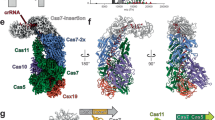Summary
The effect of acridine orange (AO)-sensitized photodynamic treatment (PD) was studied in various repair-deficient mutants of Salmonella typhimurium and Escherichia coli. Bacteria of either species carrying mutations in the polA gene and hence deficient in the enzyme DNA polymerase I were significantly more sensitive to PD-killing than polA + parent bacteria or phenotypically POL+ revertants of the polA strains (selected on the basis of resistance to methyl methanesulphonate). It therefore appears that DNA polymerase I plays an important role in cellular recovery from PD treatment. E. coli carrying a mutation in the recA gene was also more sensitive to PD-treatment than its parent strain, as was S. typhimurium carrying a mutation of the recA type. In S. typhimurium the rec mutant was somewhat less sensitive to PD-killing than the pol mutant even although it is much more sensitive to ultraviolet killing. E. coli strains with mutations in the recB and recC genes were intermediate in PD sensitivity between the recA and the parent strain. S. typhimurium and E. coli bacteria with mutations in the polA and recA genes showed reduced ability to host-cell reactivate PD-damaged bacteriophages ES 18 and λc1, indicating that the polA + and recA + gene products also contribute to repair of bacteriophages damaged by PD treatment. It is suggested that the recombinational repair process is less important for recovery from PD than for recovery from UV, and that the primary contribution of the rec genes to recovery from PD may be in repair of single-strand gaps by repair resynthesis.
Similar content being viewed by others
References
Bohme, H., Geissler, E.: Repair of lesions induced by photodynamic action and by ethyl methane sulphonate in E. coli. Molec. gen. Genet. 103, 228–232 (1968).
Cooper, P. K., Hanawalt, P. C.: Role of DNA polymerase I and the rec system in excision-repair in Escherichia coli. Proc. nat. Acad. Sci. (Wash.) 69, 1156–1160 (1972).
DeLucia, P., Cairns, J.: Isolation of an E. coli strain with a mutation affecting DNA polymerase. Nature (Lond.) 224, 1164–1166 (1969).
Eisenstark, A.: Sensitivity of Salmonella typhimurium recombinationless (rec) mutants to visible and near-visible light. Mutation Res. 10, 1–6 (1970).
Geissler, E.: Photodynamische Schädigung lysogener HCR+- und HCR--Bakterien. Biophysik 3, 94–96 (1966).
Geissler, E.: Untersuchungen über die Irreparabilität photodynamischer Schäden. Studia biophys. 2, 95–102 (1967a).
Geissler, E.: Zur Irreparabilität photodynamischer Schäden. Studia biophys. 3, 165–174 (1967b).
Gemski, P., Stocker, B. A. D.: Transduction by bacteriophage P22 in nonsmooth mutants of Salmonella typhimurium. J. Bact. 93, 1588–1597 (1967).
Harm, W.: Dark repair of acridine dye-sensitized photoeffects in E. coli cells and bacteriophage. Biochem. biophys. Res. Commun. 32, 350–358 (1968).
Harrison, A. P., Hafner, J. L., O'Brien, C.: Ultraviolet killing and photodynamic killing in mutants of E. coli. Mutation Res. 14, 447–449 (1972).
Jacob, H. E.: In vivo production of DNA single-strand breaks by photodynamic action. Photochem. Photobiol. 14, 743–745 (1971).
Janovska, E., Zhestjanikov, J., Vizdalova, M.: On the nature of repairable and non-repairable lethal damage in E. coli and bacteriophage induced by the photodynamic action of acridine orange. Int. J. Radiat. Biol. 18, 317–329 (1970).
Kelly, W. S., Whitfield, H. J.: Purification of an altered DNA polymerase from an E. coli strain with a pol mutation. Nature (Lond.) 230, 33–36 (1971).
Kuo, T., Stocker, B. A. D.: ES18, a general transducing phage for smooth and nonsmooth Salmonella typhimurium. Virology 42, 621–632 (1970).
MacPhee, D. G.: Recombination deficient mutants of colicinogenic Salmonella typhimurium detected by their failure to produce colicin. J. Bact. 104, 345–350 (1970).
Morgenroth, A., Duguid, J. P.: Demonstration of different mutational sites controlling rhamnose fermentation in FIRN and non-FIRN rha- strains of Salmonella typhimurium: an essay in bacterial archaeology. Genet. Res. 11, 151–169 (1968).
Pettijohn, A. R., Hanawalt, P. C.: Evidence for repair replication of ultraviolet damaged DNA in bacteria. J. molec. Biol. 9, 395–410 (1964).
Rupp, W. D.: Sensitivity to acridine sensitized photodynamic inactivation in E. coli B, B/r and Bs-1. Radiat. Res. 27, 544 (1966).
Town, C. D., Smith, K. C., Kaplan, H. S.: DNA polymerase required for rapid repair of X-ray induced DNA strand breaks in vivo. Science 172, 851–854 (1971).
Author information
Authors and Affiliations
Additional information
Communicated by B. A. Bridges
Rights and permissions
About this article
Cite this article
Imray, F.P., MacPhee, D.G. The role of DNA polymerase I and the rec system in survival of bacteria and bacteriophages damaged by the photodynamic action of acridine orange. Molec. Gen. Genet. 123, 289–298 (1973). https://doi.org/10.1007/BF00433647
Received:
Issue Date:
DOI: https://doi.org/10.1007/BF00433647




